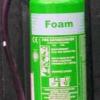All Activity
- Last week
-
Sundas SEO joined the community
-
Carole OGorman joined the community
-

Existing Notional Fire Door Remedial Work or Replacement?
Guest replied to nigelh's topic in Fire Doors and Accessories
Hi Nigel, you’ve probably had your fire door situation solved by now but thought I’d give my 2 pence on this we work with a number of agents in regards to fire door remedial/replacements though my company, and you wouldn’t believe the amount of responsible persons such as block managers and property managers that are incompetent to the regulations is crazy, they just eat out the palm of whatever inspector/contractor tells them and never ask a 2nd opinion. due to your flat being built in the late 80’s, the door will have to follow the standards which were in force in the time of building, so wouldn’t be BS EN 1634-1 like today’s installations which are heavy when coming to fire safety, your bracket would likely be BS 476, which are a touch more friendly. if your door and frame is in good condition, with no damages and is of solid construction, this can 100% be remediated to suit the fire regulations, rather than ripped out and replaced to follow BS EN 1634. A competent contractor would be able to route seals into the doors leaf, we always recommend fire and smoke seals to be installed, no matter what height as takes the same amount of work as normal fire seals, and the cost is a couple of £ more, but every little helps when coming to fire safety. (Even though The Fire Safety Regulations (2022) since August have changed in regards to this, if the door has appropriate 25mm door stops, the door may not need intumescent seals installed, subject to findings in the FRA. Due to your flat being only 2 stories and door has 25mm stops, I believe this would not need strips installed) Perkos are still approved according to The Fire Safety Regulations (2022) which was formed after the Grenfell enquiry, so as long as yours is in good working order, should be fine but we normally recommend an overhead to be installed as they are much easier to maintain and we always tell leaseholders how to adjust them, which in turn usually saves them £ over the long run as won’t need call out charges for contractors to come and adjust the perko when it eventually stops closing the door as should. (I’d never recommend anyone not competent to ever try to adjust a perko as this is a quick way to rip the tip of your finger off!) in regards to the gaps around the door, if at the time of inspection the door had the correct gaps, you’re more then right about a contractor adjusting and packing hinges with correct intumescent products, this would have sorted the issue. hope you had it all sorted and wasn’t bullied into getting a FD30s certified door set when it wasn’t needed. -
diaze-uk.net changed their profile photo
-
diaze-uk.net joined the community
- Earlier
-
Good evening, We are planning to purchase a 3 floor house. As I understand the doors between the stairwell and habitable rooms have to be (FD30) fire doors. As per the floor plan attached (I hope I was able to attach) on the 1st floow there are 2 fire doors, one between the kitchen and stairwell and another one between the living room and stairwell. We would like to move the door 2 to be door 3 (i.e. we will terminate door 2, to wall in and make a new door), and the door 3 will be a double fire door. This way there will be still firedoor between the stairwell and living room but on a different place. My question is if it can be done please? Obviosuly we have to call a structural engineer too to make some calculation but from building control perspective is it possible please? I've exchanged some email with the local building control expert but he hasn't replied yet what I have to do to get an official confirmation. Could anybody please help me? Thanks a lot! *** update *** Apologies, for some reason I can't upload image. However hopefully the floor plan can be viewed on https://drive.google.com/file/d/1E981QWdgOn_PY3Bu3oey2ieaWBQIexPZ/view?usp=sharing
-
Viktor joined the community
-
Should all lockset latching keeps which have voids be intumescent protected as standard compliancy? I have come across numerous chiselled out keeps which must surely present as fire barrier breaches
-
With regard to the voids created when installing a lock keep, should it not be a case that all such fixings should incorporate intumescent protection?
-
First floor flat own entrance, fire door?
First floor door replied to First floor door's topic in Fire Risk Assessments
Thank you for your reply. My buyers solicitor is still telling mine it doesn't meet requirements going from the FRA, I think the FRA is for the building in general as I don't think I've had a specific one done for my flat. I'm trying to contest but don't know how. Is there any information available regarding the law about the requirements you stated meaning it doesn't need one? -
The question was first asked 7 years ago, those that asked, and those that have since asked no longer post so if anyone did find a key, we will never know. 🙁 Best not to reply to old posts.
-
Thanks Anthony
-
If that is a final exit to the outside then there is every likelihood it doesn't need to be a fire resisting door so you can simply fill the holes with whatever you want to prevent draughts.
-

First floor flat own entrance, fire door?
AnthonyB replied to First floor door's topic in Fire Risk Assessments
No it isn't - an external entrance door does not need to be a fire door unless onto an external escape stair or a balcony with escape in only one direction. -
https://www.flameguardbedding.co.uk/Fire-Retardant-Pyjama-Sets-Extre--1 All sorts of special dressing gowns, nightwear, etc can be found if you search
-
247torax India joined the community
-
Fire door sign on door leading edge
Mike North replied to Hyperion's topic in Fire Doors and Accessories
ADB C12 The following fire doorsets are not required to comply with paragraph C11. a. Doors to and within flats and dwellinghouses. b. Bedroom doors in ‘residential (other)’ (purpose group 2(b)) premises. c. Lift entrance/landing doors. -
underpressureservices joined the community
-
Naz and Seal joined the community
-
Tonyc8310 started following Fire Alarm Servicing
-
We have just had a fire alarm service with a letter a large sized fire related contractor stating that we don't fully comply with BS5839 due to our zone plans don't show show doors or toilets marked up in applicable rooms. In a care home I take it they refer to ensuit facilities. The zone chart was previously done some years ago and wondering if they are reffering to the 2025 standard as they stat they work to the current standard. Is this a retrospective requirement to update everything to the 2025 standards?
-

Fire door sign on door leading edge
Neil ashdown replied to Hyperion's topic in Fire Doors and Accessories
https://assets.publishing.service.gov.uk/media/67d17064a005e6f9841a1d50/Approved_Document_B_volume_2_Buildings_other_than_Dwellings_2019_edition_incorporating_2020_2022_and_2025_amendments_collated_with_2026_and_2029_amendments.pdf Appendix C Fire Doorsets C11: Fire Door Signs. Complying with BS 5499-5. All fire doorsets should be marked on both sides, except fire doorsets to cupboards and service ducts, which should be marked on the outside. https://www.firecode.org.uk/Code_of_Practice_hardware_for_fire_and_escape_doors_issue_5.pdf Fire Safety Signs page 104 to 112. -
Is there any products on the market that would assist a supported living resident with heavy smoking. I’m aware of smoking aprons but any other suggestions would be appreciated and welcome.
-
Hi i also need a Q key, did anyone find out where to get one? thanks
-
Is this acceptable? I always thought that fire door keep shut/closed signage should be visible on both sides of the door leaf. This was the only signage on the fire door on the leading edge of the door. unfortunately it will not let me upload an image.
-
Hi, Apologies if this isn't posted in the correct place. I am currently selling my flat. It is a one bedroom ground floor in an old converted building with it's own entrance. My buyers solicitor is telling my solicitor I need to agree to install "an FD30S and provided with intumescent strips, cold smoke seals and a self-closing device, mounted on three fire rated BS 1935 hinges". My query is that my flat door does not connect to any common areas. It goes directly to the outside on the ground floor. There are no other flat entrance doors near mine. Is it a legal requirement to have my door changed before I can sell the property or not? I don't really want to spend a load of money I don't have to unless it's absolutely legally required. If it is then fair enough but none of the other flat doors with their own entrance have this. Just the common areas have proper fire doors from the hallways for the flats within the main block.
-
Rob D started following Repair or replace?
-
Hi, It's my first post there so hi everyone! I'm wondering if this door is repairable or needs replacing due to the holes in the door behind the push pad? https://ibb.co/S4v3fSbr https://ibb.co/DDNwq4t7 Otherwise the door is in good condition. Thank you Rob
-

Custodial Premises Fire Safety Design Guide (FSDG) - source?
AnthonyB replied to DBrown's topic in Fire Risk Assessments
All I can find free are: https://assets.publishing.service.gov.uk/media/6243119ce90e075f1088f5c1/ps-11-fire-safety-march-2022.pdf https://www.legislation.gov.uk/ukdsi/2018/9780111164631/pdfs/ukdsi_9780111164631_en.pdf So it looks like having to pay for it - if it's like the other ones for special sectors like BB100 for fire safety design in schools in it's depth and specific content it should be worth it if doing prisons work (have you tried asking the establishment you are working at for a copy?) -
It would very likely be possible to upgrade the fire resistance and smoke spread restriction of your flat entrance door but the term FD30(s) can only refer to either a door with product certification (which yours probably doesn't have) or a door that has been inspected/assessed by a suitably competent person as a Notional FD30(s) or Nominal FD30(s) door. Before you decide on any action, it would be worth consulting the UK Gov guidance whilst considering the location of the door in the block, fire evacuation strategy and potential risk from fire to the occupier(s) of the flat and other residents at the block. https://www.gov.uk/government/publications/making-your-small-block-of-flats-safe-from-fire/a-guide-to-making-your-small-block-of-flats-safe-from-fire-accessible and https://www.gov.uk/government/publications/fire-safety-in-purpose-built-blocks-of-flats
-

Compliant self-closing devices suitable for the elderly in blocks of flats
Guest replied to AbiL's topic in Fire Doors and Accessories
Fire doors have been installed in the block where I live plus an extremely heavy entrance door, which for senior citizens presents problems, sprained wrists and or arms and even backs. The directors maintain nothing can be done. Who can I consult on this matter, someone who would actually visit the property to inspect? Ms G J. -

Is there a legal requirement to retrofit CE marked hinges to existing fire doors?
Guest replied to a topic in Fire Doors and Accessories
Hello! I've inherited a door in a flat that I bought in mid 00's, which was a rental property. I'm now looking at renting it out again to 4 sharers, and checking regs. I've only changed the locks since bought (no other mods) and assume it was compliant at the time of buying it from the previous owner (it's an ex-council, 1930-50 constructed, single storey flat in a low-rise council-owned building) is very solid...perhaps oak (seems to be at least 30 years old - maybe older) has 2 x very solid looking gravity hinges, which are sort of self-closing (but don't close from 15º) has no seals has a viewinghole has a standard letterbox + knocker that looks aluminium has a couple of ringers (that now don't work, but don't want to remove/alter the door further) has what seems to be a formerly-glazed panel, but now replaced with what could be fairly thin plywood and painted on both sides. Is there a suitable way to make this FD30S compliant without wasting a very solid and long-lasting door/hinges? I envisage: potentially adding a hidden-frame/chain...or overhead door-closer intumescent smoke/fire strips intumescent threshold strips intumescent steel letterbox intumescent sheets retrofitted around latches/locks, and hinges potentially get new viewing hole with intumescent sheet in surround potentially get a custom pyroglass panel fitted with intumescent seals/beading/tape/fixtures Does this make sense? Is it worth it? Or do I send a very solid chunk of wood to landfill that has been doing a solid job for at least 30 years (and possibly longer!) -
ChrisS started following Plastic Choc Blocks used to join cables
-
In a retirement complex with 67 flats we have recently had a fire alarm system upgrade. We have had a new fire panel, removed fire bells from flats as the fire risk assessment said as we are a stay put site we shouldn't have them and replaced the bells in the corridors with sounders. Existing cabling was used. Where the bells have been removed from the flats the remaining cable has been joined using plastic choc blocks. These are (mostly) inside the existing round metal conduit junction box but without a lid. This is fixed to the wall and the plaster board is dabbed onto the wall leaving a gap between. Then on the flat side (apartment side) of the plaster board a metal plate has been fitted using the fixing holes of the original junction box. This results in a gap between this plate and the upper edge of the junction box. The installer says this is still classed as an enclosed metal box as fire cannot get in. Is it? Is it a fire proof situation? Is the system compliant? We have a modifications certificate.
-
i have a mid terraced house with a middle bedroom that has a window situated above a glass roof. i need an escape route. The bedroom door opens onto an open landing leading to open stairs, so i guess that is not an option. i have been advised that an escape ladder onto the glass roof is also not an option as the glass is not fire glass. The research that i have done offers limited solutions, as follows: 1. Create a fire resistant hatch into an adjoining bedroom. So go through the hatch and escape from other bedroom via window to front of the house 2. Replace the glass with fire glass (not easy to do, not practical, and likely to be expensive) 3. Build a platform above the glass and below the bedroom window onto which the escapee could stand without standing directly on the glass roof. Any help or advice would be greatfully received to resolve this matter Many thanks

.thumb.jpg.ecc4294fc7d53e96c4c562a5bc3467e0.jpg)
